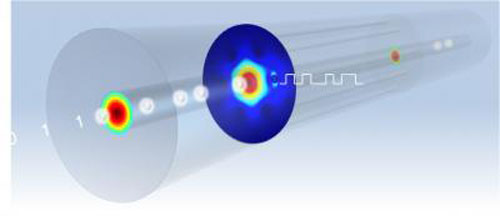Researchers have, for the first time, developed crystalline materials that enable an optical fibre to have integrated, high speed electronic functions.
According to scientists from the University of Southampton, potential applications of such optical fibres include improved telecommunications optical and electronic technologies, improved laser technology and more accurate remote sensing devices.

In a bid to embed the high level of performance normally associated with chip based semiconductors into an optical fibre, the team built an optical fibre with a high speed electronic junction – the active boundary where all electronic 'action' takes place – integrated adjacent to the light guiding fibre core. They discovered that light pulses (white spheres) travelling down the fibre could be converted to electric signals (square wave) inside the fibre by the junction. By merging a flat chip with a round optical fibre, a new way to build a new kind of optical fibre with its own integrated electronic component was discovered. This bypassed the need to integrate fibre optics onto a chip and was achieved by using high pressure chemistry techniques to deposit semiconducting materials layer by layer directly into tiny holes in optical fibres.
The big breakthrough here is that the manufacturers don't need the whole chip as part of the finished product. Moreover, while conventional chip fabrication requires multimillion dollar clean room facilities, this new process can be performed with simple equipment that costs much less.
The process has the potential to be a key enabling technology in the drive for faster, lower cost, and more energy efficient communication networks.